| Srl | Item |
| 1 |
ID:
083036
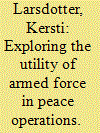

|
|
|
|
|
| Publication |
2008.
|
| Summary/Abstract |
The robust approach of the American forces in for example Afghanistan and Iraq is often criticised and compared to the more soft approach of the British forces. However, there are surprisingly few systematic studies on the relationship between the conduct of force and the outcome of peace operations. Two kinds of military conduct in Afghanistan have been explored in this article, one that could be called 'minimum force' and one that could be called 'show of force'. Contradicting the commonly held idea of the superiority of 'minimum force', 'show of force' correlated with a better outcome than the 'minimum force' approach. However, before arguing that a 'show of force' approach is a better way to conduct peace operations, more reliable data on the outcome, and additional case studies, are needed.
|
|
|
|
|
|
|
|
|
|
|
|
|
|
|
|
| 2 |
ID:
134989
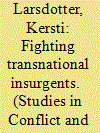

|
|
|
|
|
| Summary/Abstract |
Transnational insurgents are a common feature of contemporary wars, but research on how to address this problem is still scarce. This article examines the South African Defence Force's (SADF) counterinsurgency against Namibian transnational insurgents. It concludes that the South African forces focused a large amount of their efforts outside the borders of Namibia. Highly coercive operations in Angola and Zambia created the space for hearts and minds activities in Namibia, as well as forcing neighboring states to end their support for the insurgents. Although the war in Namibia is somewhat different from contemporary wars, SADF's cross-border strategy gives us some important insights into the regional dynamics of civil wars.
|
|
|
|
|
|
|
|
|
|
|
|
|
|
|
|
| 3 |
ID:
165098
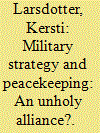

|
|
|
|
|
| Summary/Abstract |
Despite the increased use of military force in peacekeeping operations in the twenty-first century, these operations are not included in traditional strategic theory. In this article, I outline the logic of four strategies for peacekeeping operations – defence, deterrence, compellence and offence – and trace the use of these strategies in two consecutive UN operations in the Democratic Republic of the Congo: MONUC and MONUSCO. The article concludes that all four strategies are indeed used in the two operations, but they are neither comprehensive nor proactive, leaving the true potential of military strategy unrealised.
|
|
|
|
|
|
|
|
|
|
|
|
|
|
|
|
| 4 |
ID:
165096
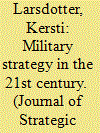

|
|
|
|
|
| Summary/Abstract |
This special issue explores military strategy in the twenty-first century. The articles scrutinise strategy from three perspectives: the study of strategy, and how our understanding of strategy has changed over time; new areas for strategic theory, i.e., areas where the development of war has made strategy become more important, such as peacekeeping operations and cyberspace; and the makers of strategy, more specifically why states choses suboptimal strategies and how wars in the twenty-first century influence strategy makers.
|
|
|
|
|
|
|
|
|
|
|
|
|
|
|
|
| 5 |
ID:
128305
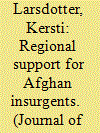

|
|
|
|
|
| Publication |
2014.
|
| Summary/Abstract |
After the fall of the Taliban regime in 2001, several thousand Afghan Taliban forces fled across the border to Pakistan, and the area became a safe haven for Afghan insurgents. In 2014, the transnational dimension of the insurgency is still highly prominent. Although regional support for insurgents is not uncommon, how to counter this aspect is mostly ignored in counterinsurgency (COIN) theory and doctrines. In this article, a regional counterinsurgency framework is developed, using the regional counterinsurgency efforts in Afghanistan as an example. The framework will facilitate the systematic inclusion of regional COIN measures in theory and doctrine.
|
|
|
|
|
|
|
|
|
|
|
|
|
|
|
|